- Discover the holy city of Varanasi through the eyes and experiences of Rishi and Arun.
Varanasi:
A passage to immortality, is a coffee table book by Rishi Agrawal and Arun Saha.
Varanasi
is a city of contrasts. The form and the formless, the real and surreal, the
life and the death all co-exist here. This timeless city invites our heart,
mind, and soul to undertake a journey within as we roam its alleys. Its
stories, legends, and myths lend an aura of magic to this spiritual heart of
the world.
The
book is a collection of 200 soulful images to spark sublime conversations. Each
page is a walk through the colourful by-lanes of the abode of Shiva and
Annapurna. The photos capture the contentment of people, brilliance of ghats,
delectable street foods, fine crafts, and exuberant festivals of this immortal
city.
The
city has a long list of celebrations involving entire communities that have
been carried on for centuries with great pomp and show. Be it the age old
Ramleela, Nag Nathaiyya, Dev Deepawali, Chaath Puja or modern day balloon
festival these events entertain and enlighten. In this book you will also
find a glimpse of these exuberant festivities that colour the life of common
folk. Below I have covered some of the most dramatic celebrations of Varanasi.
Ram Leela
While Ram-Leelas are popular across the Indian heartland today, there is
none that compares to the Ram Leela in Varanasi. Believed to have started more
than 470 years ago, it is the oldest Ram Leela in the world.
According to tradition, Sant Tulsi Das, Varanasi’s most famous Ram disciple, once had a vision of Sri Ram, Lakshman and Sita passing by Assi ghat in a tableau. It is this vision that lead him to start the custom of a Ram Leela, meaning Ram’s play. It is an elaborate play act of the Ramayana with locals as its performers.
While a Ram Leela elsewhere is enacted on a single stage, the Ram Leela
here engages the entire city, transforming it into a Ram Leela ground.
Different parts of the city serve as Lanka, Ashok Vatika etc, with elaborate
structures being built in every location. The Ram Leela play lasts for close to
a month, with each day being named after the chapter of the Ramayana that is
chosen to be enacted. The most popular one is the enactment of the Bharat
Milap, a day after Dussehra. It is a show so spectacular that has inspired several
paintings and poems, and draws in crowds large enough to shut down parts of the
city, every year.
Families in Varanasi have been participating in the Ram Leela for
generations, with new members taking on roles every decade or so. Every
tradition is followed to the last detail, so the essence of theatrics here has
remained the same for close to five centuries. It is interesting to note that
unlike most Ram Leelas, the Ramnagar Ram Leela does not use microphones and
electronic speakers. Despite crowds of thousands, the actors perform their
lines without any aids, chanting and reciting their lines as they relive the
epic in its truest form.
Ganga Aarti
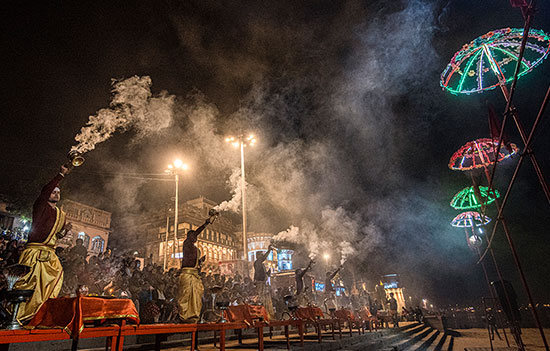
The Ganga Aarti is Varanasi’s crowning glory. Each evening, thousands of devotees gather at the ghat to watch priests offer prayers to Lord Shiva, the Ganga, to Agni and the whole universe.
The ghat is equipped with colourful canopies and platforms to host the murti
of goddess Ganga. Each evening, hundreds of devotees and tourists assemble here
by the river to watch the aarti. While it may seem like the ghat is spilling
with people, there always seems to be enough room for everyone to soak in the
experience.
At 6:45 pm, the conch shell is blown and lamps are lit aflame; then the
aarti begins with a chorus of chants. The pandits ring brass bells as the
magnificent oil lamps are brought up to the platform and the aarti erupts into
a crescendo of prayers and lights. The aarti lasts for forty-five minutes, at
the end of which flowers are offered to the murti and conch shells are blown
once again.
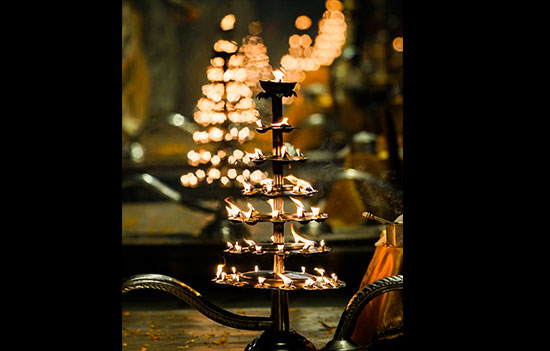
The wonderful mix of music, prayers and bright lights leaves you feeling
transfixed, with a strange sense of peace. As the atmosphere rings with energy
and palpable belief, watching the Ganga aarti becomes a surreal experience even
for the non-believer.
Nag Nathaiya
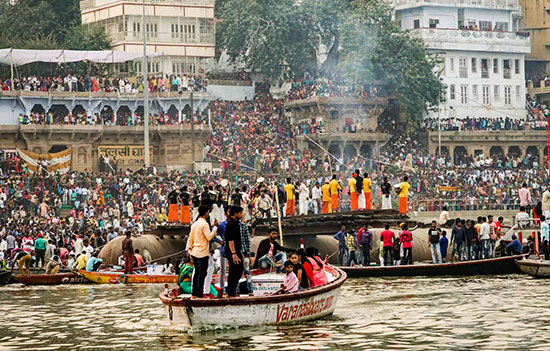 Crowds at Tulsi Ghat to experience Nag Nathaiya.
Crowds at Tulsi Ghat to experience Nag Nathaiya.
Another of Varanasi’s finest celebrations is the Nag Nathaiya, a festival to commemorate the victory of Sri Krishna over the deadly snake Kaliya Nag. It is believed to have been started in the 16th century by Sant
Tulsi Das at the ghat now known as the Tulsi Ghat.
In yet another elaborate play-act, young boys are chosen to play the role of Sri Krishna, the mischievous and charming cow herd, who is a form of Vishnu himself. The boys plunge into the river Ganga from a branch of the Kadamba tree to defeat the poisonous snake. They then emerge from the river with the snake’s severed head with a flute in hand, striking a pose in front of their audience.
Nag Nathaiya is believed to be one of the most significant parts of Krishna’s early life and is celebrated across Varanasi in the months of November and December, with hundreds of people flocking to the city to witness it.
Dev Deepawali

Dev Deepwali, different from Diwali, is the city’s favourite festival. Celebrated on Kartik Purnima (full moon day of the Hindus) the festival also goes by the name Tripurotsav.
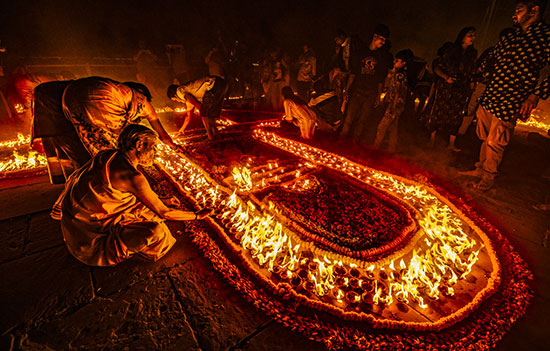 Lighting diyas.
Lighting diyas.
On this auspicious day, thousands of devotees take a cleansing holy dip
in the Ganges, signifying the cleansing of sins and rejuvenation of the soul.
Thousands of diyas are lit and released along the banks of the Ganges to
welcome the gods. From Ravidas Ghat to Rajghat, lakhs of diyas adorn the
landscape with bewitching charm.
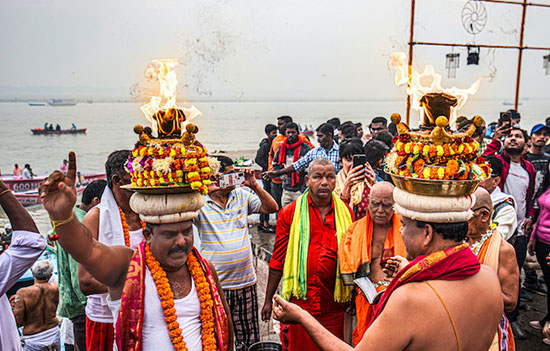 Celebrations by Telegu speaking brothers on Dev Deepavali.
Celebrations by Telegu speaking brothers on Dev Deepavali.
Balloon Festival
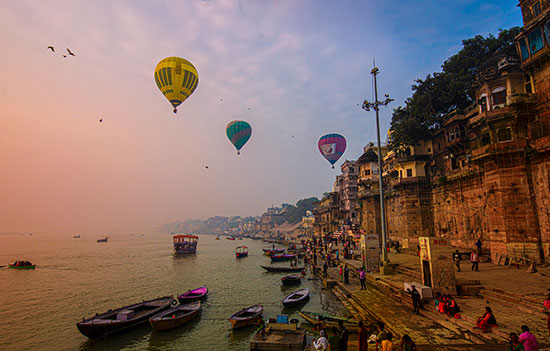
Balloon Festival is a modern and recent addition to the city of heritage
and handlooms. Celebrated over a three day period coinciding with Dev
Deepawali, a bumpy ride in the colourful balloons provides a magnificent aerial
view of the ghats and human expanse unlike any other in the world.
Chhath Pooja
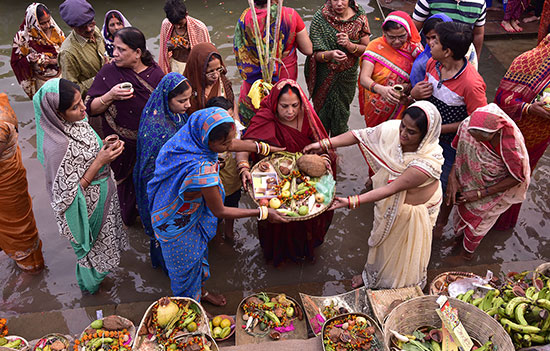
Chhath Puja is one of the most beautiful and revered festivals in
eastern India. It is celebrated to offer gratitude to the Sun God for being
generous with the yield of crops. Offering Chhath prayers in Ganga is
considered as the highest form of devotion.
Among the four days, devotees offer prayers to the setting sun on day one
symbolizing the ending of the year and with that the good and the bad. On day two
devotees offer prayers to the rising sun, marking the beginning of the new
harvest season. All the ghats of Varanasi are used extensively for celebrating
Chhath.
Aakash Deep Celebration
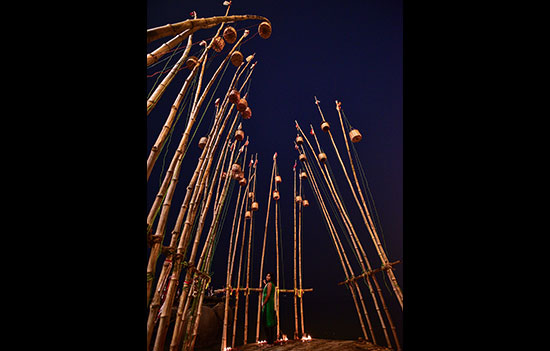
Aakash deep starts from the day of Sharad Purnima and ends on Kartik
Purnima, when it is celebrated as Dev Deepavali. It is the lighting of oil
lamps during the twilight period and night in Kartik month.
The lamps are placed along the ghats by community priests and ordinary
people from neighborhood
communities alike. It is believed that lights from
the traditional oil lamps lit in Kartik Maas (month) will lighten the path for
the souls of dead ancestors to reach heaven. Thousands of Hindus participate in
this month-long ritual dedicated to dead relatives and ancestors.
 Pic of Husband/Wife leaving a diya in the Holy Ganga is a very common sight at Kashi.
Pic of Husband/Wife leaving a diya in the Holy Ganga is a very common sight at Kashi.
To see a video (.57 seconds) on the book
Authors - Rishi Agrawal is an IIT BHU Kashi/IIM Calcutta graduate who is now
a technology entrepreneur.
Arun Saha is ex The Indian Airforce and now a photographer based in Pune.
Editor – The coffee table book Varanasi – A Passage to Immortality has an excellent collection of pictures and
matter for e.g. there is section on Sadhus and Food which I loved. Production
values very good. The write up in each chapter is good too. All places of
pilgrimage, invariably have very good food, Kashi is no exception.
To
buy the book on Amazon.
It is by Author Rishi and Arun Saha. I sincerely hope the book motivates
you to visit Kashi. Look for deeper experiences and observe people-fascinating.
Do make it a point to visit Banaras Hindu University and Sarnath.
Also read
1. Why
is Varanasi a pilgrimage destination
2. Album
Dev Deepavali
3. Album
People of Kashi celebrating Dev Deepavali during day
4. Varanasi
pics in black and white
5. Why
does everyone love Varanasi
6. Ramnagar
Fort album
7. Sarnath
album
8. Cultural Contributions of Marathas to Kashi